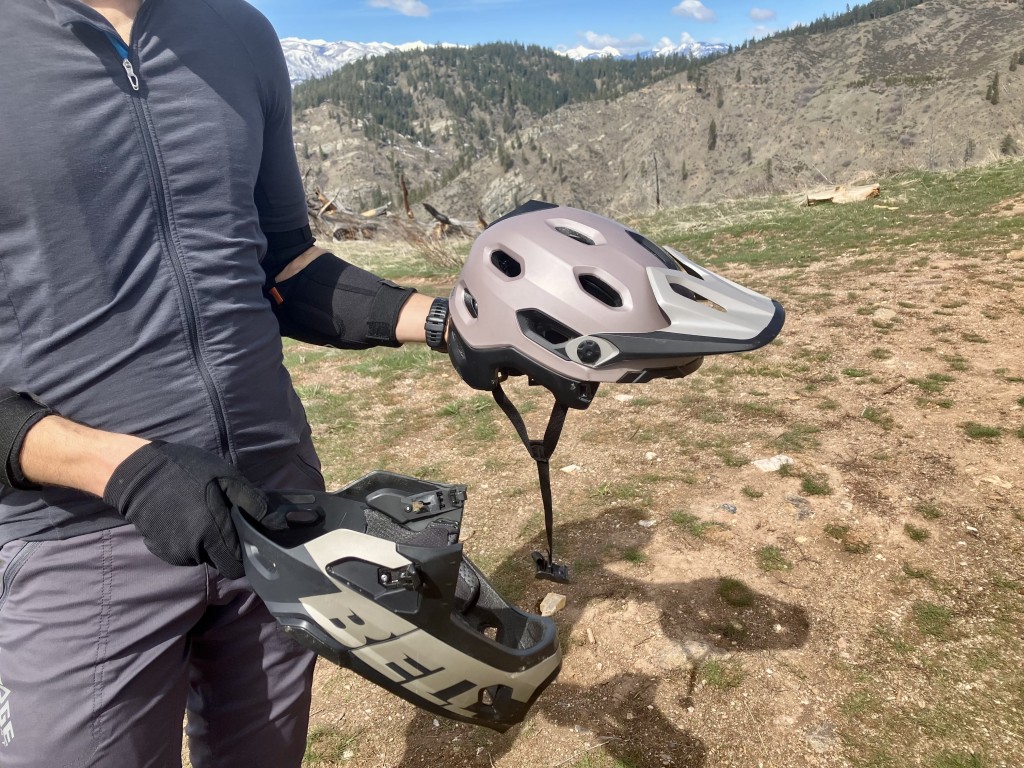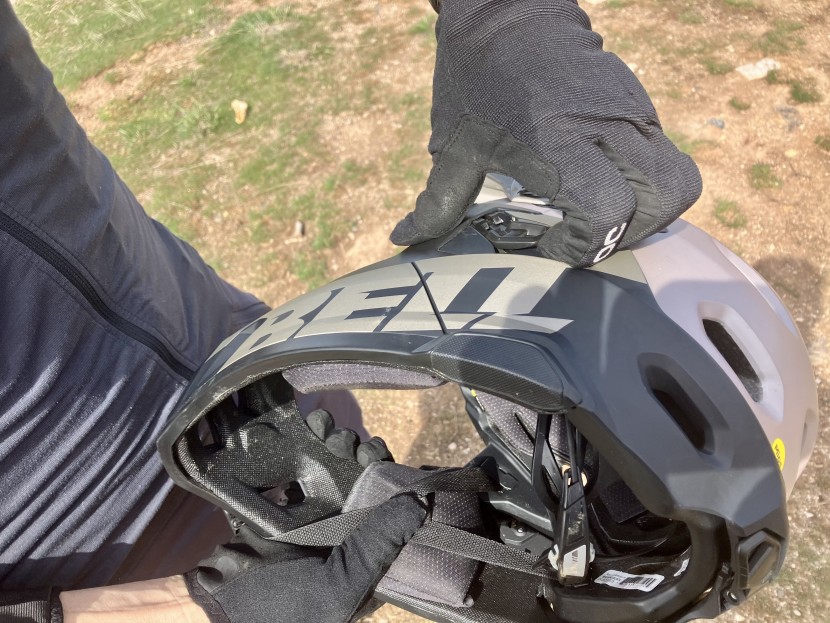Bell Super DH Spherical Review
Our Verdict
Compare to Similar Products
 This Product
Bell Super DH Spherical | |||||
|---|---|---|---|---|---|
| Awards | Best Convertible Helmet | Best Overall Full Face | Best For Enduro Racing | Best Balance of Price and Performance Downhill Helmet | Best Buy Downhill Helmet |
| Price | $204.99 at Evo Compare at 3 sellers | $186.00 at Evo Compare at 4 sellers | $199.99 at Evo Compare at 4 sellers | $149.95 at Evo Compare at 3 sellers | $170 List $149.99 at Amazon |
Overall Score  |
|||||
| Star Rating | |||||
| Bottom Line | A high-end and versatile full-face helmet with a removable chin bar that offers solid protection | A killer enduro lid that works well for shuttle laps or the racecourse | A comfortable enduro-oriented lid that feels protective while being relatively light and very breathable | A park-worthy helmet at an attractive price that offers serious protection | A comfortable helmet with solid protection levels at an excellent price |
| Rating Categories | Bell Super DH Spher... | Smith Mainline Mips | Fox Racing Proframe RS | Troy Lee Designs D3... | Leatt Gravity 2.0 |
| Comfort (25%) | |||||
| Protection (20%) | |||||
| Weight (20%) | |||||
| Ventilation (15%) | |||||
| Visor (10%) | |||||
| Durability (10%) | |||||
| Specifications | Bell Super DH Spher... | Smith Mainline Mips | Fox Racing Proframe RS | Troy Lee Designs D3... | Leatt Gravity 2.0 |
| Weight (grams, size medium) | 473-grams-half shell 878 grams-full face | 765 grams | 836 grams | 1219 grams | 1008 grams |
| Weight (ounces, size medium) | Half shell: 16.8 oz Full face: 31 oz |
27.0 oz | 29.5 oz | 43.0 oz | 35.5 oz |
| Number of Vents | 19 helmet, 2 brow ports, 4 chin vents | 21 | 22 | 20 | 11 |
| Shell Material | Polycarbonate | Aerocore | Polycarbonate | Fiberglass | Polymer |
| Rotational Impact Protection System | MIPS Spherical | MIPS | MIPS Integra | None | 360 Turbine |
| Sizes | S, M, L | S, M, L | S, M, L | XS, S, M, L, XL, XXL | XS, S, M, L, XL, XXL |
| CPSC | Yes | Yes | Yes | Yes | Yes |
| CE EN1077 | No | No | No | Yes | No |
| CE EN1078 | Yes | No | Yes | Yes | Yes |
| ASTM F1952 (DH) | Yes | Yes | Yes | Yes | Yes |
| ASTM F2032 | No | No | Yes | Yes | No |
| ASTM F2040 | No | No | No | No | No |
Our Analysis and Test Results
The Super DH Spherical posted strong scores in most performance metrics. Comfort and protection were two areas where this helmet stood out as particularly impressive. Its weight and ventilation were not as impressive. Still, we loved the Super DH for its high level of versatility thanks to its ability to transform from a trail-shredding half-shell to a downhill-certified full-face helmet in a matter of seconds.
Performance Comparison
Comfort
The Super DH is a comfortable helmet in both half-shell and full-face modes. In half-shell mode, the Super DH has a soft feeling against the head. There is a cradle that holds the helmet, and place and tension can be adjusted by a dial in the rear of the helmet. Although the tension dial is small, it is easy to use thanks to its deep grooves that provide texture and grip for your fingers. Simply tighten or loosen this dial to adjust cradle tension.
Another noteworthy feature is that you can adjust how this cradle sits on your head. By altering the position of the cradle with a simple snap, you can make the helmet feel like it is sitting deeper on your head. Our tester needed to select one of the lowest cradle positions to achieve a desirable fit.
The Super DH uses a FidLock buckle which utilizes magnets to secure the helmet. Instead of clipping the helmet closed with a traditional system, simply guide each end of the strap towards each other, and the magnet will do the rest. To remove the helmet, riders can use one hand to push each side of the magnet in opposite directions to disengage the clip. The FidLock clip sits flat against your neck/chin and feels pleasant.
In full-face mode, the Super DH remains comfortable. Putting the helmet on can be a little tricky as you need to pull the cradle out of the way as you slide your head into the helmet. Traditional full-face helmets don't often have this inner cradle system. It isn't a big deal, but there is no denying that it provides a bit of an obstacle.
Once the helmet is on your head, there are no pressure points or hot spots. Your ears have plenty of room, and they don't feel squished like they often do in a heavily padded DH-focused helmet. In fact, we were impressed by how well you can hear while wearing the Super DH. The chin bar is definitely a little closer to your mouth than many other helmets, but it doesn't affect comfort levels or performance significantly. When bouncing down your favorite rough trail, the helmet stays in place and doesn't shift around. The Super DH integrates well with goggles.
Protection
The Super DH Spherical offers excellent levels of protection. If you need a helmet for downhill racing or ripping park laps all summer, there are burlier, more robust options. For riders who want a convertible helmet for shuttle laps and the occasional park day, the ATSM F-1952 downhill-certified Super DH is a fantastic choice.
The Super DH Spherical uses a Polycarbonate shell and multiple layers of EPS foam. The most noteworthy safety feature is the Spherical Technology. Spherical Technology attempts to achieve the same goal as the popular Mips slip plane found in many helmets. The goal is to reduce the rotational forces that reach the brain by allowing the helmet to absorb some of that rotation. Where a Mips plane is a visible layer of plastic under the pads near your head, Spherical technology is hidden within two layers of the helmet's foam. This rotation within the helmet is designed to reduce the risk of rotational forces that reach your brain in the event of an angled impact.
With all of this talk about the convertible helmet, now is a good time to address how this all works. The chin bar attaches to the upper helmet with three latches, one at each temple and one at the rear. These latches are actuated by small levers that allow hooks to securely pull the chin bar into the upper helmet. Removing the chin bar is a bit quicker than installing it. The chin bar can be removed without taking the helmet off after a little practice. Installing the chin bar requires you to remove the helmet.
On the trail, the helmet feels protective and confidence-inducing. Among the enduro-focused helmets in our test class, the Super DH is amongst the most robust. No, it is not a pure downhill helmet, but for most endeavors, it offers plenty of protection.
Visor
The Super DH has an infinitely adjustable visor. Simply loosen the two thumb screws above the temple and simply pivot the visor up and down to achieve the desired position. This simple system works well. The visor has a large range of adjustment, and any rider should be able to find a position that suits them.
Visors have grown in length in recent years. In half-shell mode, the visor is definitely on the longer side of the spectrum. In full-face mode, it is shorter than much of the competition. The visor is a bit flimsy and flexible; this is likely an attempt to keep it from cracking easily if the helmet is dropped or you crash on it. In other words, it is designed to bend more easily than it breaks.
Weight
In full-face mode, our medium Super DH weighs a measured 878 grams. In half-shell mode, the helmet weighs 473 grams. Interestingly enough, that means the chin bar constitutes almost half of the total weight of this helmet.
On the trail, the helmet feels about average in weight. There are lighter options available, but few have a downhill certification and such a robust feel on the trail.
Ventilation
The Super DH sits in the middle of the road as it pertains to ventilation. When we tested the previous version of this helmet, it was pretty light and airy. Since then, there have been a huge number of extremely light and well-ventilated full-face helmets that have come to market. This new class of ultralight and airy helmets includes convertibles and fixed full-face helmets. Still, considering its downhill certification, the Super DH breathes well.
In half-shell mode, this helmet offers 19 vents and two brow ports. The vents aren't particularly large compared to the competition, but they do serve their purpose. We would have absolutely no issue wearing this helmet on full-day, epic trail rides.
In full-face mode, the Super DH is pretty effective at letting the air escape, especially compared to the heavily padded, downhill-focused helmets in this review. That being said, it also doesn't promote airflow the same way as some of the lightest options in the review do. We certainly would not call this a hot or clammy helmet, but there are better options if ventilation is a chief concern.
Durability
Throughout testing, we observed no sign of premature wear or breakdown of materials. Everything is still functioning perfectly.
One area that will bear watching is the three latches that secure the chin bar. After a couple of seasons of heavy use, we wonder if these small levers will stand up several hundred cycles of removing or securing the chin bar. It should be reiterated that we didn't experience any issues, but it is something worth monitoring.
Should You Buy the Super DH Spherical?
The Super DH is best suited for enduro riders and occasional park riders looking for a highly-versatile helmet. Riders who need to grind up long fire roads to get to the top of rowdy downhills will love this helmet. It is also a nice option for enduro racers who wish to remove the chin bar for the transfer stages. The Super DH is also a strong option for e-bike riders. In addition, riders who don't want to have to buy a downhill helmet and a trail helmet will really appreciate the versatility offered by the Super DH.
What Other Full Face Helmets Should You Consider?
If you plan on riding the chairlifts dozens of days per season, racing downhill, or sending the biggest gaps you can find, it is worth looking at a dedicated downhill helmet such as the Smith Mainline Mips or the Fox Rampage Pro Carbon Mips. If you need something a bit more budget-friendly, we recommend the Troy Lee Designs D3 Fiberlite. This model offers solid performance at a reasonable price point.















